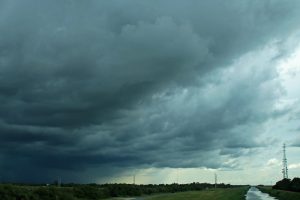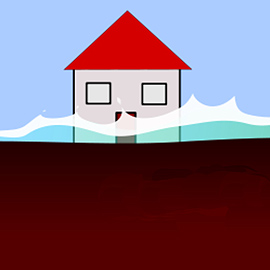With Hurricane Florence’s strike of North and South Carolina, experts from UConn School of Medicine’s Center for Indoor Environments and Health are urging high awareness and caution about the potential hazards of mold-related illnesses following severe flooding.
In addition to the ocean and river storm surges, Hurricane Florence is pounding the Carolinas with heavy rain leading to catastrophic flooding.
 “Where there’s dampness and water, there’s mold,” stresses Paula Schenck, M.P.H, of the UConn Health Division of Occupational and Environmental Medicine. “Mold is an indicator of a whole soup of biological material. Unhealthy exposure to these bioaerosols is very possible after a flood from a hurricane and especially during clean-up efforts 24-48 hours after the storm.”
“Where there’s dampness and water, there’s mold,” stresses Paula Schenck, M.P.H, of the UConn Health Division of Occupational and Environmental Medicine. “Mold is an indicator of a whole soup of biological material. Unhealthy exposure to these bioaerosols is very possible after a flood from a hurricane and especially during clean-up efforts 24-48 hours after the storm.”
This exposure primarily affects the respiratory system and skin. Severity depends on the individual, and the extent and duration of exposure. Those who are asthmatic, immune-compromised, children, or chronically-ill maybe at increased risk. However healthy individuals can also be vulnerable to mold-related exposure, especially when cleaning up after a storm where the amount of mold-related materials provides a significant dose of the offending agent.
It is important to note, that environmental-related symptoms and illnesses can look and feel like common, non-mold related health issues – and there may be a delayed on-set of symptoms.
Warning signs and symptoms of mold-related exposure may include:
1. Nasal congestion and sneezing.
2. Voice hoarseness and throat irritation.
3. Cough, wheezing, shortness of breath or chest tightness.
4. Exacerbation of asthma symptoms.
5. Respiratory symptoms and severe fatigue.
Since those affected by mold may not associate these symptoms with exposure, clinicians are urged to maintain a heightened post-storm awareness in the coming weeks and months for possible patient mold exposure symptoms.
UConn Health has readily available “A Guide for Your Safety- After the Storm- Mold and Moisture Cleanup.”
UConn Health experts recommend these protective steps post-storm during mold clean-up:
1. If areas have been flooded and/or subject to wetness for more than 24 hours, assume the presence of mold and related biological material, even if you can’t see it. But remember if your personal health puts you at higher risk, do not engage in clean up yourself.
2. Use a respirator (minimal protection is the NIOSH-approved N95 respirator. Make sure it is labeled “N95” and includes bands to hold the mask close to your face). Basic dust and surgical masks do not protect against bioaerosols such as mold and mold spores.
3. Wear protective clothing. Make sure to cover all skin on your arms, hands, legs, and feet.
4. To protect your eyes wear unvented goggles.
5. Clean up mold on hard surfaces with soapy water, and wear long rubber gloves that extend to the middle of the forearm to protect your skin.
6. Unless there is added contamination from other flooded materials such as sewage do not use bleach or other “fungicides.” These chemicals introduce respiratory irritants and are not any more effective than scrubbing with soapy water.
7. Soft materials and porous surfaces, like fabrics and wall board, that have been damaged should be discarded and replaced.
8. Seek professional help if the damage is extensive, greater than 100 square feet.
To learn more visit the website of UConn Health’s Center for Indoor Environments and Health for mold exposure health information, physician guidance and free online courses for physicians and healthcare providers for mold and moisture patient care.



